Joaneath started in the Dutch Cabinet rooms with an explanation of the "hang" at the Walters. The 17th Century in Dutch art is considered the "Golden Age" dominated by several amazing painters - Rembrandt, Rubens, Vermeer, for example. The National Gallery of Art in Washington has rooms with such masterpieces. The Walters has not one. But, as Joaneath said, our museum is not required to put out a sign that says, "We have no Rembrandts here," so the Walters has chosen to play on its strengths and offer visitors a different sense of the past.
There are two Dutch Cabinet rooms, designed to show how such rooms in the Dutch Republic would have looked in about 1690. Even the walls and woodwork are characteristic of 1690. Joaneath noted how the molding on the dark colored walls creates frames, and noted how the Dutch at this time were developing a sense of "decor" new to sensibilities at the time. Paintings within a "frame" created by the molding tended to stick with a theme, and the organization of paintings gave the patron an ability to be a bit creative.
Holland was ruled by William and Mary in 1690, and English things would have been coming into the country. At this time in history, Protestant courts and countries stuck together, as did Catholic courts and countries, and the "twain" did not often meet. The Protestantism of the Dutch Republic was highly influential on its art. The Dutch, particularly, were seagoing people and explorers. Thus, a Dutch merchant's home would likely have contained Chinese porcelains, and it was a major shift to see such porcelains used purely for decorative purposes.
Joaneath pointed out the chest, which was made by a Dutch craftsman and decorated with a Westerner's view of Eastern subjects. From the catalog:
This cabinet was made by a Dutch craftsman to imitate the expensive lacquered Chinese and Japanese chests imported by the Dutch East India Company. The painter adapted some motifs, such as the pagodas on the drawer fronts, from Chinese porcelains, but the figures are only Asian by virtue of their long embroidered coats with sashes. The headwear, including feather headdresses, is completely fanciful. Some figures are actually Native Americans, adapted from engravings of 1584 reporting English explorations of Virginia. On the exterior side panels are remarkable adaptations of engravings recording a French expedition of 1564 to Florida. Young "Floridians" play competitive games while beautiful birds imaginative renderings of the bird of paradise from the East Indies swoop around them. The maker surely hoped that his customers would just enjoy the exotic details.
Also part of the new emphasis on "decor" was the introduction of the practice we would now call "tablescaping," designed to showcase objects not just for their aesthetic beauty but to create a pesonal narrative for the owner of the home. So for example, this Russian drinking cup might show that the merchant had frequent trade in Russia, an important trading partner of the Dutch at the time.
During the early 1600s, Dutch merchants were in Moscow actively pursuing the Russian fur trade. They brought gifts for the court that apparently included Dutch metalwork, which influenced the style of local craftsman. Their work, in turn, would have been prized as gifts to be taken back to Holland. This characteristic "bratina" (from the Russian "brat," meaning brother) was to be passed around at feasts. The embossed, chased decoration with masks and flowing forms draws on the work of Dutch silversmiths at mid-century, epitomized by Johannes Lutma.
Although Russia may have been considered the "wild west" at the time, the Dutch developed good relationships with the Kremlin. The Kremlin now has a large collection of Dutch silver made by Dutch craftsmen for Russian tastes. Small objects traveled easily and became part of a culture of mercantile gift exchange.
The Dutch imposed their own ideas of beauty on foreign things, such as this carving and casing for an exotic coconut shell from a foreign clime. The inscription read "drunkenness is the root of all evil." There are also incriptions indicating that the shell was carved by a father and mounted in silver by his daughter in his honor.
On to the paintings.
The first Dutch room is somewhat dominated by this painting of Prince Maurits with his horse and groom. While it may seem odd to focus so much on the horse, Joaneath noted that Prince Maurits was successful as the commander of the republic's military forces and as a breeder of horses. Maurits is depicted in a field in a kind of "double portrait" with an immense dapple-gray war horse that he is training. It may be the offspring of a prize dapple-gray Spanish war horse (a breed famous since antiquity), captured by Maurits's forces from the Spanish Habsburg commander Archduke Albert, bred with a heavier northern European war horse. Thus, the horse represents a trophy.
Animal subjects were becoming more popular in the 17th C. As religious art declined in Protestant Holland, painters chose other ways to show that the message of God can be found all around. Other new subjects included landscapes and, particularly for the Dutch, seascapes. The sea was a source of wealth and pride for the Dutch, as well as a source of death and danger, and their art reflected it. By the end of the 17th C., landscapes reflected an emphasis on the enormity of sea and sky, and thus the fragility of life. Diagonal lines draw the eye up to the sky, which takes up 2/3 of the painting.
It was in the Dutch Republic that the family portrait first became a significant subject, particularly among the middle class. This is due, in part, to the important role of women in Dutch society as well as to the prosperity and political power of the middle class. The seated parents are surrounded by their children, who stand in respect. The souls of infants who died young or were stillborn hover above. The rural setting indicates that the family has property; however, their attire is sober, excepting the lustrous, East-Indian pearls worn by the girls, possibly to suggest the dowries they will bring to marriage. In addition, the two girls of marriageable age carry roses - they are "ripe for the picking." The boys have one hand on the hip, a gesture of determination, associated in portraiture with the man "on guard," ready to defend the family. Maybe the family members did all look alike, but, more likely, this provincial artist was unable to register the distinctions.
Finally, we were on to the Chamber of Wonders.
The entrance to the suite of rooms containing the Chamber of Wonders is designed to be typical of Northern Renaissance mansions. In the North, it was typical to show the arms and armor of your ancestors, and collectible items acquired on campaign. Turkish armor might have been taken from dead enemies; Japanese armor may have been acquired as diplomatic gifts. By the 16th and 17th C., firearms were also part of the regular arsenal, but tournament armor remained important. Boys' armor was designed to look like their fathers', and boys participated in tournaments.
Off to the side is the collector's study, where the wealthy scholar would retreat to literally "study" objects collected by or for the scholar. Collectors at this time developed a passion for organizing their objects, but without much information they resorted to grouping them by material or type. "Study" was done by a process of compare and contrast. In this room, that convention has been followed, so there are cases of objects in metals, in glass or rock crystal, in ivory, and in wood, to name a few. Around the top of the room are portraits of inspiring people. Commonly found in such studies were watches and timepieces, which were objects of wonder, as well as skulls and "memento mori" to remind the scholar that while genius lives on, all else is mortal.
The Chamber of Wonders is literally a "crown jewel" of the Walters.
There is an important wunderkammer tradition, and books aplenty have been written about it. According to Joaneath, it can be described as a tradition of exploration and wonder. In other words, things come to you, you value those things for what they can teach you, and you wonder - where did it come from? What does it mean? What is happening? In an age upset by the notion that the sun is the center of the universe, God's plan was not clear. Those who cultivated their chambers of wonders believed that God revealed Himself in the extra-ordinary - miracles, omens, signs. To study these one must bring together extraordinary things and try to create a sense of order. Extraordinary things from nature, from human achievement, from the heavens, all were studied for the purposes of drawing connections and making sense of the world. What makes a group? Things that fly? What about a flying squirrel (or a square mouse, as they called it)?
Paintings recorded these attempts. And paintings also recorded virtuosity, the hand of the artist. There are many paintings of things that scholars wished to study. So, for example, this Panorama of the Abduction of Helen Amidst the Wonders of the Ancient World by Heemskerck is an homage to ancient art in Rome. 16th- or 17th-century Europeans could call on this celebration of ancient ingenuity to validate their own. In 1535, when Heemskerck painted this panorama, scholars were still disputing which of these monuments were the most marvelous. This luminous panorama is one of the most famous Northern landscapes of the 1500s; its array of ancient marvels and evidence of antiquity's greatness provided a picture-puzzle for the viewer, challenging him to locate and identify the pieces. The point of studying these wonders is not to know that they were beautiful but to wonder: How did they do it?
Joaneath was very excited to show us this remarkable portrait of a wealthy man of African ancestry from Renaissance Europe. She noted that the chain he wears is of the type usually received as a gift for service in a royal Court, marking this individual as someone of rank and privilege. It must have been possible for a person of African descent to rise to social heights in the age of wonders and marvels.
On to a painting that we have seen before, and will use often on tours. Joaneath's description matched almost precisely this description from the catalog:
This painting of a private gallery or cabinet of a Flemish collector depicts a visit by Archdukes Albert and Isabella, the Habsburg governors of the Southern Netherlands. Isabella is seated, while her husband stands to her right and their unidentified host, behind. The walls are covered with paintings by Flemish artists [but other small objects in the room are from all over the world]. The sculpture displayed throughout is from various schools, but includes the bronze "Allegory of Architecture" by Giambologna, a Flemish sculptor who made his fortune in Florence. A painted "Allegory of Iconoclasm," depicting people who destroy art as animals, rests against a chair. Visitors examining paintings and objects on the tables draw the viewer's attention to these objects, as well as shells and a stuffed bird of paradise, from the Spice Islands. Pets include a monkey, kept out of mischief on a chain, and a dog, apparently with two heads (an alteration by the artist that has "bled" through). The globe-like object on the table at the left is one of Cornelis Drebbels' attempts at a perpetual-motion clock; the principles which ran it are now lost. Albert's and Isabella's role as rulers and patrons of the arts is celebrated here in an unprecedented way. The immense vase of flowers by Jan Brueghel, the greatest Flemish flower painter, is crowned by a large sunflower. This South American flower which could grow to be 14 feet tall and could turn toward the sun, was first seen by Europeans in the mid-1500s. It had been illustrated as a New World wonder in botanical treatises, but this is its earliest inclusion in a painting and its earliest use as a symbol of princely patronage. In turning to the sun (but here toward Albert and Isabella), it symbolizes the way that the arts grow and blossom in the light and warmth of princely patronage.
Joaneath compared the use of the sunflower in our painting to the famous self-portrait by Van Dyke with the sunflower turning to its source of life, the painter. [This painting is now in a private collection.]
She also noted the symbolism of another flower in the arrangement, the Crown Imperial, also evoking royal patronage.
In general, artists in the age of "wonders" enjoyed painting impossible arrangements of flowers, using flowers from different countries, even continents, and from different seasons. It was almost like saying the artist had more power than God, but not quite.
Finally, Joaneath told us a series of amusing stories about acquiring the natural specimens in the room. Chambers of wonders almost always included "natural wonders" and the Walters Chamber had to have a lot. Still, there was no budget for acquiring things that were not "art." Joaneath set about a program to acquire each of the natural history specimens using no museum funds. Some she did purchase on eBay, then compiled a list for private donors to reimburse her. But she also contacted hunters, asking for specimens they shot. She scoured sources for confiscated items. The great sea turtle shell had been confiscated by the government and was being held in a warehouse in Denver - the government agreed to donate that, and other things, provided only that any object must fit into a FedEx box.
The sawtooth on the wall had an especially interesting story. Joaneath despaired of finding one because of legal limitations on the catching and use of such objects. When she had almost given up, she attended a crafts fair on her own time and came upon a stall of "nautical art." There, with a lovely painting across it, was the sawtooth she'd been looking for. She ascertained that it was legal to buy (it was, having been caught long before the ban) and purchased it. The lovingly-executed painting by an unknown nautical artist is turned to the wall, so that the Walters visitors may enjoy the "wonder" of this exotic sea specimen.
There is so much to see in and to say about the Chamber of Wonders. It is one of the best places in the museum.
Next week, on to Islamic art.
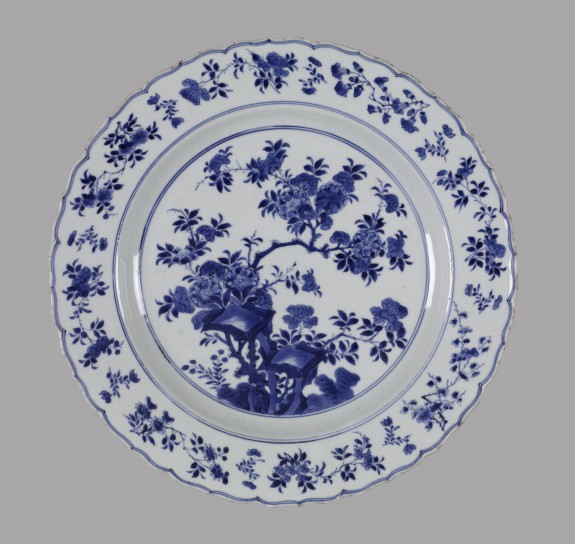




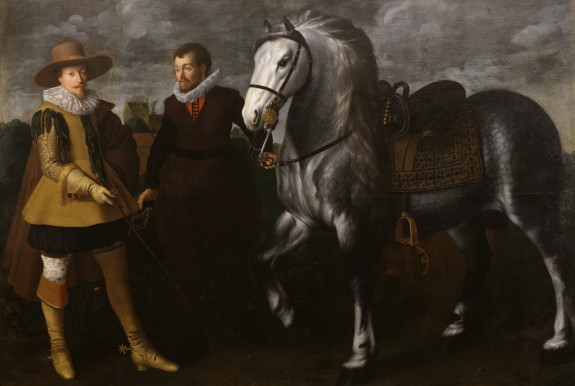
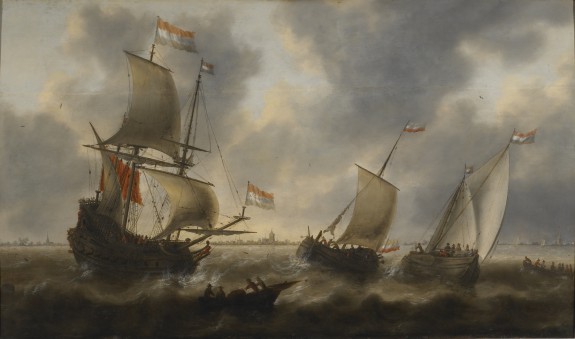
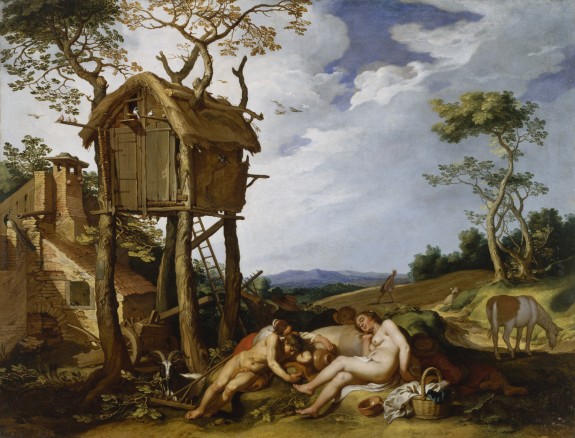


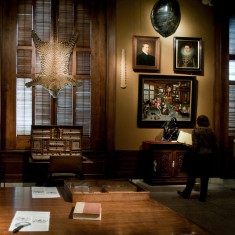
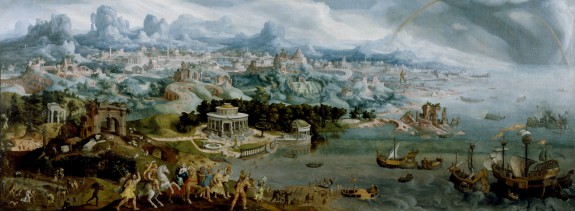

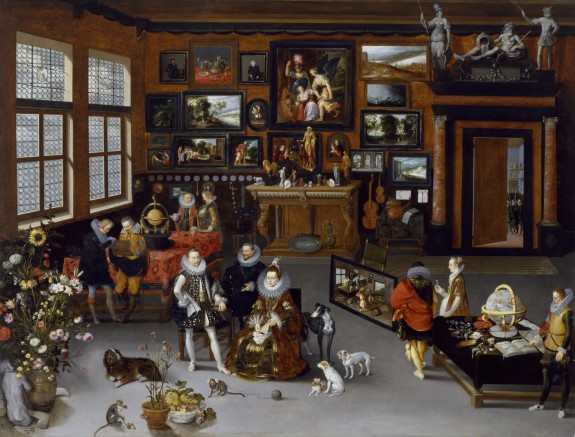


No comments:
Post a Comment